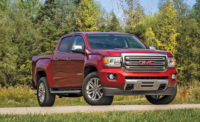GM Pickups for 2014 Get New Looks, Engines






At first glance, the 2014 Chevrolet Silverado 1500 and GMC Sierra 1500 light-duty pickup trucks appear mildly evolved. A taller front end mimics current heavy-duty GM trucks, the track has been widened for greater stability, the doors have been reshaped to make the cabin quieter and the bulging wheel wells give the pickups a more rugged look.
But how do they perform as work trucks? Three new engines are addressing that challenge, in addition to an interior with greater storage, a more flexible mix of body styles, powertrains and drivetrains and a few other touches.
Nuts and Bolts
When the light-duty 2014 Chevy Silverado and GMC Sierra go on sale this spring, they will be available with three new engines: a 4.3-liter V-6, a 5.3-liter V-8 and a 6.2-liter V-8. Hybrids will not be available for 2014, and there is no plan to add a diesel to the half-ton mix.
If the engine sizes look familiar, they should—they're all offered on the outgoing models. While displacement hasn't changed, almost everything else has. Dubbed EcoTec3, the 2014 V-6s and V-8s feature aluminum blocks, higher compression ratios, direct injection, variable valve timing, and GM's Active Fuel Management cylinder-deactivation technology, which limits power to four cylinders under light-load driving situations. A six-speed automatic transmission is standard on all the trucks.
GM has not yet released any engine, towing or payload specifications, but company executives promise that the new engines will provide increased power and fuel efficiency. In terms of the trucks' ability to tug trailers and haul loads, GM executives simply said they "expect improvements."
The new engines face tough challengers. Ram has updated its product line for 2014 with class-winning fuel efficiency, and Ford's powerful and efficient 3.5-liter EcoBoost V-6, introduced for 2011, has quickly become the mill of choice for an increasing number of F-150 buyers.
Ford and GM are following different philosophies, with Ford going the way of smaller displacement engines and turbocharging while GM sticks with a more traditional route.
"We think a larger displacement engine is a better solution than smaller, more complex twin-turbo engines," says Jeff Luke, executive chief director of GM trucks. "We're skeptical of the long-term costs" associated with smaller turbocharged engines, adds Tom Wilkinson, Chevrolet spokesman.
ENR echoed these concerns when it first tested the Ecoboost F-150, but it should be noted that the turbocharged engine has served customers over the past couple of years without developing a record of poor reliability. Ford is said to be unveiling a sneak peek of the 2015 F-150 at the Detroit auto show later this month.




